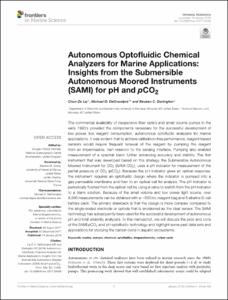Autonomous Optofluidic Chemical Analyzers for Marine Applications: Insights from the Submersible Autonomous Moored Instruments (SAMI) for pH and pCO2.

View/
Average rating
votes
Date
2018Author
Lai, Chun-Ze
DeGrandpre, Michael D.
Darlington, Reuben C.
Metadata
Show full item recordAbstract
The commercial availability of inexpensive fiber optics and small volume pumps in the
early 1990’s provided the components necessary for the successful development of
low power, low reagent consumption, autonomous optofluidic analyzers for marine
applications. It was evident that to achieve calibration-free performance, reagent-based
sensors would require frequent renewal of the reagent by pumping the reagent
from an impermeable, inert reservoir to the sensing interface. Pumping also enabled
measurement of a spectral blank further enhancing accuracy and stability. The first
instrument that was developed based on this strategy, the Submersible Autonomous
Moored Instrument for CO2 (SAMI-CO2), uses a pH indicator for measurement of the
partial pressure of CO2 (pCO2). Because the pH indicator gives an optical response,
the instrument requires an optofluidic design where the indicator is pumped into a
gas permeable membrane and then to an optical cell for analysis. The pH indicat.....
Journal
Frontiers in Marine ScienceVolume
4Issue
Article 438Page Range
11pp.Document Language
enSustainable Development Goals (SDG)
14.aEssential Ocean Variables (EOV)
N/ADOI Original
https://doi.org/10.3389/fmars.2017.00438Citation
Lai, C-Z, DeGrandpre, MD and Darlington, RC (2018) Autonomous Optofluidic Chemical Analyzers for Marine Applications: Insights from the Submersible Autonomous Moored Instruments (SAMI) for pH and pCO2. Frontiers in Marine Science, 4:438, 11pp. DOI: https://doi.org/10.3389/fmars.2017.00438Collections
The following license files are associated with this item:
 Repository of community practices in Ocean Research, Applications and Data/Information Management
Repository of community practices in Ocean Research, Applications and Data/Information Management
